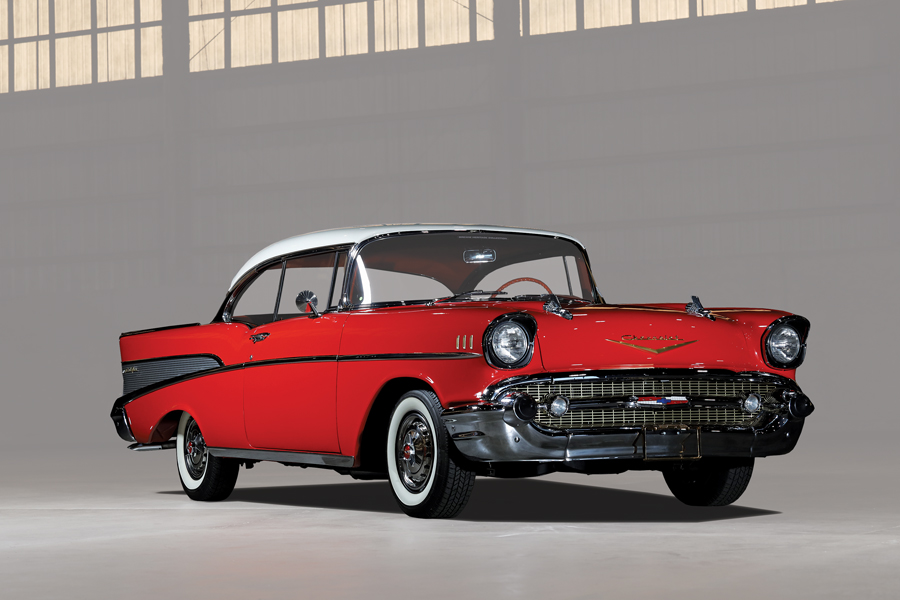- Two-year frame-off restoration
- Super Turbo-Fire 283-ci V8
- Dual 4-bbl carburetors
- 2-speed Powerglide automatic transmission
- Matador Red and India Ivory
- From the Vault Collection
SCM Analysis
Detailing
| Vehicle: | 1957 Chevrolet Bel Air 2-door hard top |
| Years Produced: | 1955–57 |
| Number Produced: | About 450,000 (2-door hard tops only) |
| Original List Price: | $2,399 |
| SCM Valuation: | $39,500 |
| Tune Up Cost: | $200 |
| Chassis Number Location: | Driver’s side door jamb |
| Engine Number Location: | Block stamping at pad on front passenger’s side |
| Alternatives: | 1955–56 Ford Fairlane, 1954–58 Buick Century, 1955–57 Pontiac Chieftain |
| Investment Grade: | C |
This car, Lot 636, sold for $62,700, including buyer’s premium, at the Barrett-Jackson Northeast 2019 auction, held June 26–29, 2019.
The venerable Tri-Five Chevrolets are foundational vehicles in the collector-car world. There are a lot of reasons for that, but our theory is simple: People like the cars that were hot when they hit their teenage years. For the first wave of Baby Boomers, that’s the late ’50s.
Millions of these Chevys looked great on American roads in that era, and by the time the Boomers were learning how to drive, they were affordable as first cars.
It’s more than nostalgia, though. GM’s designers were on point in this era. Similar rides from Buick, Pontiac, Oldsmobile, and Cadillac were all breathtakingly pretty. Ford and Mopar fans can say the same about their brands. It was a golden age for new engine power, new technology, and new enthusiasm for the automobile.
A modern market
Today, the oldest Baby Boomers are in their mid-70s and the youngest (including this writer) are in their mid-50s. To put it bluntly, we’ve got money, we’ve got time, and most of us are still well enough to enjoy a collector car. But there are fewer of us than there were 10 or 20 years ago, and that has an effect on the market.
Also, many Boomers have already built or purchased their dream Tri-Fives and are effectively out of the market. Those demographics have been bringing down values on Condition #2 and #3 cars for years.
Back about 2014, our Pocket Price Guide showed the range on a 1957 Bel Air 2-door hard top as $49,000 to $69,000, with the median about $59,000. By 2018, that had dropped to a $44,000 median, and this year’s median estimate is $39,500. A 30% drop in five years in a generally rising market ought to be a wake-up call. A glance through recent auction sales shows most of these cars falling in the $30,000–$50,000 range, with a few outliers.
Here’s another important thing to remember: In the first five months of 2019, we recorded 168 Tri-Five Chevrolets crossing the block. The total for 2018 was 333 cars. So there are plenty to choose from. Thirteen of the last 20 Tri-Fives to be presented at auction sold. A few convertibles broke into six figures, with a high-water mark of $180,000 for a customized 1957 Bel Air convertible, and that one was a no-sale (ACC# 6902696).
This car
To illustrate the situation, take a look at this 1957 Bel Air hard top. The car is decked out in spectacular Matador Red with white two-tone, and a devastating red-over-black interior. Under the hood you’ll find a Super Turbo-Fire 283-cubic-inch small-block V8 with two 4-barrel carbs, mated to a 2-speed Powerglide automatic transmission. There are a few obvious upgrades to modern standards such as the alternator, battery and intake manifold, but nothing you couldn’t show with pride.
This car is well above median in quality and presentation, and with its twin-carb engine certainly rates the 30% price bump the Pocket Price Guide suggests for special equipment. So the $62,700 price tag is not only justified, it’s right in line with expectations. Similar cars have been selling for similar money all year long.
Whither the Tri-Five?
Predicting the future is always an opportunity to look like a fool later, but if we make a comparison to another iconic collector car that appeals to a slightly older audience, maybe the crystal ball will uncloud a bit.
Prices for traditional 1932–34 Ford hot rods first created by the Greatest Generation have been dropping. It’s not uncommon to find those trading hands under $20,000 these days, though top examples from famous builders still command big money.
More than 120 such cars have appeared at auction so far in 2019, so again there’s a lot of volume in the market. The same phenomenon is also happening with other models from the 1930s and ’40s. How many people are hunting for a 1940 sedan today?
The hard fact is this: As people who remember any particular car in its first incarnation age out of the car-collecting business, the supply of restored or maintained cars will mostly hold steady, but the market for those cars will shrink. That will bring prices down, especially on Condition #2 and lower examples.
The good news is that the Tri-Five (and the ’32 Ford) will always remain collectible, and a #1 example of any body style will always bring top money; even from those born long after the car was made. Some things, it seems, really are timeless.
(Introductory description courtesy of Barrett-Jackson.)
